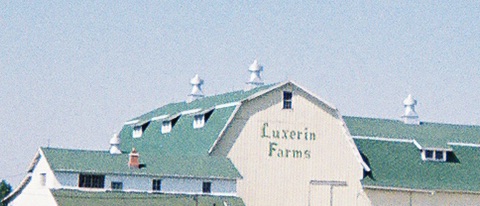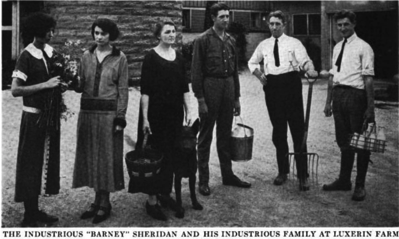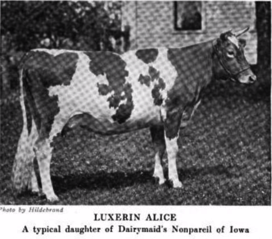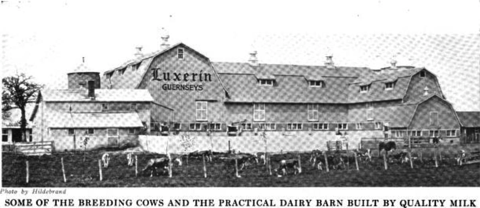
Pioneering in Quality Milk
B. F. Sheridan Backed His Judgment
with Hard Work and Won
by Lincoln L Crosby
An article from: The Field Illustrated - January 1924
Back in 1903 a young man who had spent practically all of his life on a farm devoted to sheep and grain raising became convinced that Wisconsin was destined to become a great dairy state. He accordingly rented his Home Farm and set about assembling a herd of dairy cattle. Prices of milk in those days were far from encouraging to a beginner. Milk was just milk then. But this young man had an idea. He believed people would pay for quality in milk just as they paid for quality in any other class of goods they bought. Not being satisfied with his market, he purchased in 1908 a smaller farm of 115 acres about 2 miles from the city limits of Fond du Lac. To carry out his idea, a bomb was erected that combined the latest improvements of the day. It was well lighted and ventilated and, above all, clean and sanitary. This man with a new idea had the equipment to produce quality milk and he set about producing it. Surroundings were such that a number of physicians invited him to send his milk to the city and one winters day, about 12 years ago, he drove into Fond du Lac with 10 quart bottles of his superior product tucked under the seat. A part of these bottles were delivered to customers at $0.10 a quart when other dealers were charging only five and six cents. Thus it was that Fond du Lac acquired its taste for quality milk, and B. F. Sheridan, more familiarly known as "Barney", put into action his pet idea.

Quality milk was a success from the start. At the end of the first year, Mr. Sheridan had to build a new barn to accommodate more cows and his business group beyond its wildest dreams. Today he is delivering daily into the city of Fonda Lac 500 quarts of milk and 25 quarts of cream. The milk is the product of his own Guernseys herd while the cream comes from his brothers' herd, also Guernseys.
But all this was not the result of luck or especially advantageous position. It required patient and painstaking work to educate the public to the superior quality of Luxerin Guernsey milk. And a quality product is not produced by careless methods.
To begin with, Mr. Sheridan established a plant could turn out the best grade of milk, and he has adapted his methods to such production. He watches the health of his cows and they are tested regularly for tuberculosis. the milk utensils are sanitary and the milk goes from the cows to the bottles in the shortest period of time period all of the bottles are washed and sterilized before they enter the bottling room, which is separated from the washroom by a partition to guard against any chance of disease-laden bottle combining in contact with the fresh milk. Milking is done by hand and the milk is aerated and bottled at a temperature of 45 degrees within a few minutes after it is drawn from the cows. Under this method, with healthy cows, the bacteria count is kept down to the requirements of certified milk.
Mr. Sheridan maintains an open house and anyone is welcome to inspect his plant at anytime. In fact, he prefers visitors to see the place in its working clothes. The people of Fond du Lac know his milk is clean, pure and of the highest quality. His policy of inviting prominent citizens out to the farm and of using liberal space in local papers, has educated the public to the value of quality milk and the fact that it cannot be produced at the price of the common product. So effective has the education campaign been that the people of Fond du Lac consume more high-quality milk per capita than any other city of like size in the country.
After Mr. Sheridan had been in business a few years, he was confronted with the problem of supply. There was a demand that would consume the product of another herd. He put on an extra delivery truck and started out to supply the demand but soon found that there was a point of diminishing returns in his business as in any other. The extra truck ate up the profit.

Just in time, F. J. Rueping was found in his high-class Guernsey heard right outside the city. The 60 head of producers found a solution to Mr. Sheridan's problem period city health authorities, doctors, nurses and other interested citizens were invited by Mr. Sheridan to visit his farm one afternoon. Mr. Rueping was also invited to the meeting and when he heard what the visitors had to say about quality milk, he saw the demand for such a product he equipped his Corium farms to produce milk along the lines that had proven so satisfactory at Luxerin. Now the little city is consuming the supply of three large herds at $0.15 a quart while ordinary milk is selling as low as eight cents.
But during these years Mr. Sheridan had not given all his time and attention to the milk business. About the time he purchased the farm he also bought his first purebred Guernsey; three heifers and a bull. The immediate results of the purchase were none too encouraging, for abortion and sterility left but little of the progeny of two heifers and the bull. Luckily the remaining half are resisted almost every disease a cow is air to, and this disease resistance seemed to be transmittable to her offspring. This heifer and the bull, Eminent of Sania, secured later, proved important factors in the development of the herd. The first ten daughters of Eminent of Sania to come in milk averaged 556 pounds of fat as two-year olds, there being 4 double letter class leaders among them. This bull was followed by Dairyman Nonpareil of Iowa and several good cows were also purchased and put on the test. Nonpareil now has sixteen young daughters in the herd and is the sire of Lilia of Iowa 2nd with a record of 998.4 pounds of fat. Today the herd numbers about 90 head, 45 of which are milking. There are nine head on test at all times and aside from these 26 cows have records averaging 586 pounds of fat, many of these being made in double letter classes at immature ages.

Mr. Sheridan owes his success to the strength of his convictions. He saw an opportunity to improve his market and profits and although his idea was new, he backed his judgment with hard work, good business and square dealings, and one out. In Speaking of the question of special markets he says: “I believe that where special markets can be had for the product of a currency heard, that the possibilities today are greater than ever. We had to establish this market but today the custom consumers are pretty well sold on the quality idea, generally. I also firmly believe that if the public is given assurance of quality dairy products in all forms, that they will readily respond in both consumption and price to the extent that the whole industry can be made immensely profitable.” 12 years ago Mr. Sheridan was a pioneer in the quality milk business in the central West. His success has been an incentive and example for other dairymen who have seen an opportunity to create a market of their own and increase the returns from their herd. What “Barney” has done is within the means of any progressive dairyman situated near the point of consumption. A wealthy patronage is not essential to the development of a quality milk market, for Fond du Lac is not a wealthy city. What is required, of though, is a good healthy herd with a facility to put out a quality product and the ability on the part of the owner to convince the public that there are two distinct kinds of fluid milk, one with quality and the other without. Mr. Sheridan says: “If the public could know the difference in the two kinds of milk there would be no question about marketing all the quality milk that could be produced.”
That the public is becoming educated in this manner is evident from the increasing number of dairymen who are selling the product of their herds at a premium above market prices. Many good herds show a nice profit on the sale of quality milk, and the surplus breeding stock represents an extra premium to the purebred breeder.

